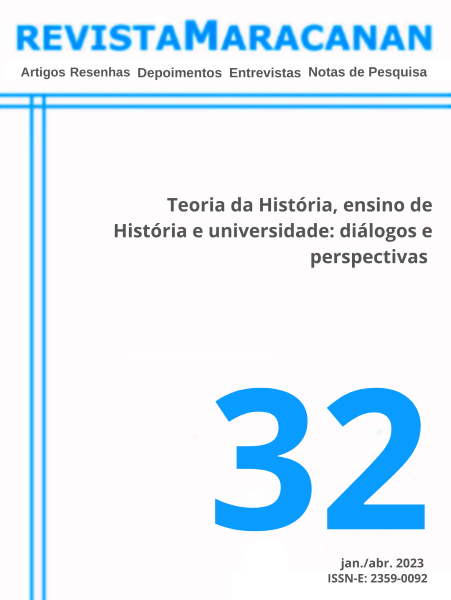The lazarists of Cosme Velho: educational policy and practice in Rio de Janeiro in two times
DOI:
https://doi.org/10.12957/revmar.2023.69749Keywords:
Medellín Document, Liberating Education, Civil-Military Dictatorship, Memory, Journalistic AgendaAbstract
This article starts from a set of documents from the National Information Service (SNI) whose target was Colégio São Vicente de Paulo, located in the Cosme Velho neighborhood in Rio de Janeiro. Some teachers and students appear in the documentation, which is now disqualified as a center of agitation and political ideas linked to communism. Based on these data, we problematize the article taking into account that the trajectory of the Lazarists in Brazil was understood in the 19th century precisely because of its conservative aspects. The study of the documentation showed how this change in the pedagogical proposal of the school of the Lazaristas took place and how it was received mainly in the midst of a middle class that used its educational services in the context of the Brazilian civil-military dictatorship and its political opening in the years 1980.
References
ANDRADE, Mariza Guerra de. A educação exilada. Colégio do Caraça. Belo Horizonte: Autêntica, 2000.
AQUINO, Rubim Santos Leão (Entrevista). Estudos Históricos, Rio de Janeiro, v. 21, n. 41, p. 95-114, 2008. DOI: https:://doi.org/10.1590/S0103-21862008000100006.
ASSMANN, Hugo. CEHILA: uma nova maneira de estudar a história da Igreja e da teologia na América Latina. Revista Caminhando, Universidade Metodista de São Paulo, v. 1, n. 1, p. 65-69, 2009 [1982]. Disponível em: https://www.metodista.br/revistas/revistas-ims/index.php/Caminhando/article/download/1506/1532. Acesso em: 7 jul. 2022.
BARROS, José D’Assunção. História e historiografia: todas as interações possíveis. In. BARROS, José D’Assunção (Org.). A historiografia como fonte histórica. Petrópolis, RJ: Vozes, 2022.
MAINWARING, Scott. Igreja Católica e política no Brasil (1916-1985). São Paulo: Brasiliense, 2004.
MICELI, Sergio. A elite eclesiástica brasileira. Rio de Janeiro: Bertrand Brasil, 1988.
PALLARES-BURKE, Maria Lúcia. Gilberto Freyre: um vitoriano nos trópicos. São Paulo: Ed. Unesp, 2005.
PIMENTA, Silvério Gomes. Vida de D. Antônio Ferreira Viçoso, bispo de Mariana e conde da Conceição. Marianna, MG: Typographia do Bom Ladrão, 1876.
PINTO, Jefferson de Almeida. Abrindo as portas da Casa de Rilhafoles: Os lazaristas e o movimento jacobeu em Portugal no século XVIII. Passagens: Revista Internacional de História Política e Cultura Jurídica, v. 12, n. 2, p. 271-295, 2020. DOI: https://doi.org/10.15175/1984-2503-202012206.
PINTO, Jefferson de Almeida. Os lazaristas e a política imperial – a escola, a assistência e a família. Topoi, Rio de Janeiro, v. 17, n. 32, p. 153-175, 2016. DOI: https://doi.org/10.1590/2237-101X0173209.
SILVA, Ana Paula Barcelos Ribeiro da. Diálogos sobre a escrita da história: Brasil e Argentina (1910-1940): ibero-americanismo, catolicismo, cooperação intelectual, (des)qualificação e alteridade. Brasília: FUNAG, 2011.
SERBIN, Kenneth P. Padres, celibato e conflito social: uma história da Igreja Católica no Brasil. São Paulo: Companhia das Letras, 2008.
SMITH, Sean A. Succeeding the Jesuits: the Congregation of the Mission and the Colégio da Purificação in Evora. Vincentian Heritage Journal, v. 33, n. 2, 2016. Disponível em: https://via.library.depaul.edu/vhj/vol33/iss2/1. Acesso em: 4 ago. 2022.
Downloads
Published
How to Cite
Issue
Section
License
The copyrights of originals and translations published are automatically assigned to Revista Maracanan. The information contained in this papers are the sole responsibility of the authors.
The Copyright of the published articles belong to Revista Maracanan, with works simultaneously licensed under a Creative Commons Attribution-NonCommercial-ShareAlike 4.0 International License, which allows the sharing of work with mandatory recognition of authorship and initial publication in this journal, under the same license and for non-commercial purposes.

The Revista Maracanan is licensed with a Creative Commons Attribution-NonCommercial-ShareAlike 4.0 Internacional License.





